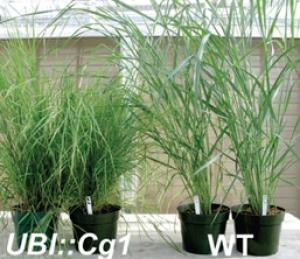Nov
28
Much More Energy from Switchgrass
November 28, 2011 | 2 Comments
The team of JBEI researchers, working with researchers at the U.S. Department of Agriculture’s Agricultural Research Service (ARS), has demonstrated that introducing a maize (corn) gene into switchgrass, a highly touted potential feedstock for advanced biofuels, more than doubles (250 percent) the amount of starch in the plant’s cell walls and makes it much easier to extract polysaccharides and convert them into fermentable sugars.
The gene, a variant of the maize gene known as Corngrass1 (Cg1), holds the switchgrass in the juvenile phase of development, preventing it from advancing to the adult phase.
Blake Simmons, a chemical engineer who heads JBEI’s Deconstruction Division and one of the principal investigators for the research said, “We show that Cg1 switchgrass biomass is easier for enzymes to break down and also releases more glucose during saccharification. Cg1 switchgrass contains decreased amounts of lignin and increased levels of glucose and other sugars compared with wild switchgrass, which enhances the plant’s potential as a feedstock for advanced biofuels.”
Lignocellulosic biomass is the most abundant organic materials on earth. Studies have consistently shown that biofuels derived from lignocellulosic biomass could be produced in the United States in a sustainable fashion and could replace today’s gasoline, diesel and jet fuels on a gallon-for-gallon basis. Nature, however, does not make it easy. Unlike the starch sugars in grains, the complex polysaccharides in the cellulose of plant cell walls are locked within a tough woody material called lignin.
Among potential crop feedstocks for advanced biofuels, switchgrass offers a number of advantages. As a perennial grass that is both salt- and drought-tolerant, switchgrass can flourish on marginal cropland, does not compete with food crops, and requires little fertilization. A key to its use in biofuels is making it more digestible to the fermentation microbes.
The magic is in the choice of the gene offering the expression. George Chuck, lead author of the paper and a plant molecular geneticist who holds joint appointments at the Plant Gene Expression Center with ARS and the University of California (UC) Berkeley explains, “The original Cg1 was isolated in maize about 80 years ago. We cloned the gene in 2007 and engineered it into other plants, including switchgrass, so that these plants would replicate what was found in maize. The natural function of Cg1 is to hold plants in the juvenile phase of development for a short time to induce more branching. Our Cg1 variant is special because it is always turned on, which means the plants always think they are juveniles.”
Chuck and his colleague Sarah Hake, another co-author of the paper and director of the Plant Gene Expression Center, proposed that since juvenile biomass is less lignified, it should be easier to break down into fermentable sugars. Also, since juvenile plants don’t make seed, more starch should be available for making biofuels. To test this hypothesis, they collaborated with Simmons and his colleagues at JBEI to determine the impact of introducing the Cg1 gene into switchgrass.
The result astonishes – in addition to reducing the lignin and boosting the amount of starch in the switchgrass, the introduction and overexpression of the maize Cg1 gene also prevented the switchgrass from flowering even after more than two years of growth, an unexpected but advantageous result. “The lack of flowering limits the risk of the genetically modified switchgrass from spreading genes into the wild population,” said Chuck.
Its not a perfect answer yet. For example, the Cg1 switchgrass biomass still required a pre-treatment to efficiently liberate fermentable sugars. But then all the other cellulose based systems do as well. Then the questions about propagation and cultivation need addressed.
Simmons looks at the results and the future about where it should lead saying, “The alteration of the switchgrass does allow us to use less energy in our pre-treatments to achieve high sugar yields as compared to the energy required to convert the wild type plants. The results of this research set the stage for an expanded suite of pretreatment and saccharification approaches at JBEI and elsewhere that will be used to generate hydrolysates for characterization and fuel production.”
Another point, which may prove more worthwhile over time, pertains to the mechanism by which Cg1 is able to keep switchgrass and other plants in the juvenile phase. “We know that Cg1 is controlling an entire family of transcription factor genes,” Chuck said, “but we have no idea how these genes function in the context of plant aging. It will probably take a few years to figure this out.”
The team’s results, about a week earlier than a study out of the UK, illustrate how far and fast biomass production could go. The UK folks seem to think that about a fifth of global energy demand could be met by biomass without harming food production. The article about the study notes there has been a debate raging. One wonders why there is any debate at all . . .
250% is quite a disrupter and challenges the cellulosic industry to get the processing costs down.
Now the question comes if the gene will transfer into miscanthus as well. If it does and one or both field trial as well as the lab trials the biomass outlook will be vastly changed for the better.
Comments
2 Comments so far



I wonder if this switchgrass could become a feedstock for the pyrolytic conversion of lignocellulose into sugar?
The third world is facing a wave of famine that is unprecedented in modern times. But, if we take this modified switchgrass and convert it into pyrolytic molasses it would seem to be a low cost food supplement that could save millions of lives.
Is it not mostly pelletised and burned directly in furnaces?
If it can be made edible that would be great, but has that ever been done successfully with lignin based feedstocks?